Featured Fly Tiers The Calcasieu Pig BoatBy John Peterie The Calcasieu Pig Boat is probably the most famous of Tom Nixon's flies. On several occasions John and Tom compared notes on how best to tie the Pigboat. John incorporated Tom's suggestions and Tom incorporated Johns. Materials List
Tying NotesThe Pig Boat's overall length is two and one-half to three-inches long. Traditionally, the rubber hackle skirt and the head on a Pig Boat are black with the body, composed of chenille palmered with saddle hackles, any color you want it to be. Use extra-large chenille for the body. If not, wind the chenille over itself until you build a body that is at least one-quarter inch thick. The hackle palmered through the chenille body should be saddle hackle like Whiting American Saddle Hackle. Use Size A tying thread when tying the Pig Boat. It allows you to torque down on the bunches of rubber legs to ensure that they will stay where you put them. The heavy thread also allows you to build the Pig Boat's head quickly. Medium size round rubber works best for the Pig Boat's skirt. Four bunches of legs are tied in on the near side, top side, far side, and bottom of the hook in four seperate steps. Each bunch contains 14 strands of rubber for a total of 56 strands. The strands should be about 12" long. The eye's pupil and iris can be applied with differnent sized pieces of wood dowels or different sizes of stove bolts. Simply dip the tip of the dowel or bolt in the paint and lightly touch the head with the paint. Some tiers also use the butt end of different sized electric drill bits to achieve the same effect. After the painted eyes have dried, apply epoxy to the head to finish it. Five minute epoxy works best. Don't skip this step. It really makes the head look great. Editors Note: If you don't have epoxy or don't like to use it, try Loon Hard Head Flyfinish. It may take several coats of the finish but it will achieve the same effect.. Angling TipsUse a 6-weight or heavier rod with either a weight-forward floating or sink-tip line depending on what kind of water is being fished. I fish the Pig Boat with a strip-pause-strip-pause retrieve but occasionally vary the type of retrieve depending upon the mood of the fish I'm chasing. Even though the Pig Boat was originally designed to catch big bass in Southwest Louisiana's Calcasieu River it is also an effective saltwater fly. I have taken several Red Drum with it in the Gulf. Tying Instructions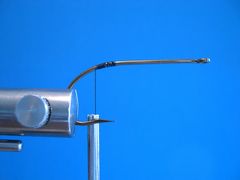 Step 1 Clamp the hook in the vice, crimp the barb, and attach the thread at the hook point. Cover the hook's shank with close tight wraps of thread for an eighth of an inch or so behind the hook point. 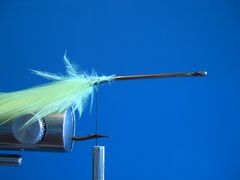 Step 2 Tie in two or three saddle hackles by their tips from the front of the thread wraps to the back of the wraps as shown in the photo. 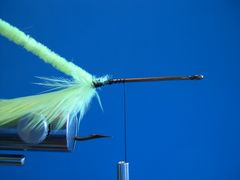 Step 3 Remove ethe fluff from the chenille to expose the core and tie it at the base of the hackle. 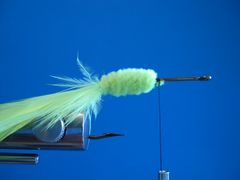 Step 4 Wrap the chenille forward to the half-way point on the hook's shank. If necessary, wrap the chenille over itself until you form a body that's at least 1/4" thick. 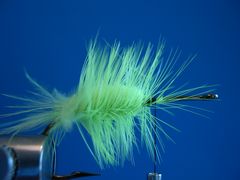 Step 5 Wrap the first feather forward to the front of the chenille body. Leave space between the hackle wraps for the second hackle. Tie off the hackle with a couple wraps of thread and remove the excess. Wrap the second hackle forward to the front of the chenille body with the second hackle falling in place between the wraps of the first hackle. Tie off the hackle with a couple wraps of thread and remove the excess. 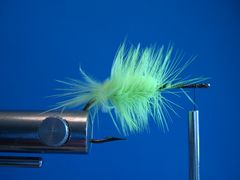 Step 6 Lay down a thread base from the chenille body to about 1/8th to 3/16th inch in front of the hook's eye in preparation for installing the skirt. 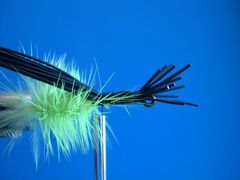 Step 7 Tie in the first bunch of round rubber hackle on the near side of the hook's shank and bind it down with close tight wraps from the front of the thread base back to the chenille body. Apply a whip finish or two half-hitches. Return the thread to the front of the thread wraps in preparation for tying in the second bunch of rubber. 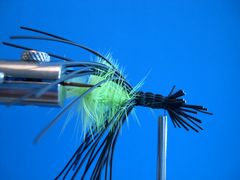 Step 8 Tie in the second bunch of rubber strands on the far side of the hook binding them down with close tight wraps from the front of the thread base back to the chenille body and apply a whip finish or a couple of half-hitches. 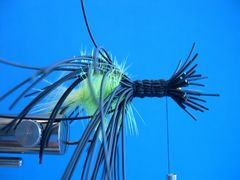 Step 9 Add the third bunch of rubber strands to the top of the hook in the same manner that you added rubber strands in steps 7 and 8. 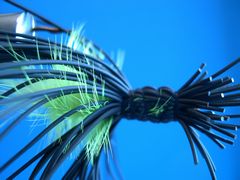 Step 10 Tie in the final bunch of rubber strands on the bottom of the shank using the same procedures that you used with the previous three bunches. The thread should end up directly in front of the chenille body before the final whip finish is done. 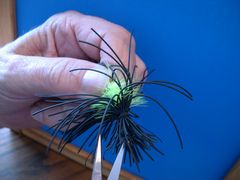 Step 11 Remove the Pig Boat from the vice. Clip the thread binding down the butts at the hook's eye and carefully and neatly trim off all of the rubber butts. 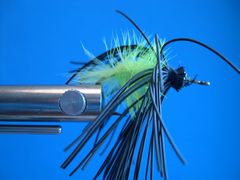 Step 12 This is the way the fly should look after the rubber strands have been trimmed. 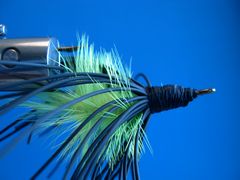 Step 13 Beginning at the chenille body, wrap the thread in close tight wraps over the rubber and continue to wrap the thread from back to front to form a pointed head. This is accomplished by using lots of thread pressure while you are wrapping the thread. It causes the rubber to stretch and move toward the eye of the hook. Once you are satisfied with the size and shape of the head tie off the thread with a whip finish or a couple of half-hitches. The thread head does not have to be smooth. The epoxy will smooth everything out later. 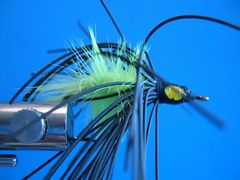 Step 14 Apply paint to each side of the head to form the yellow iris for the eyes.There are different ways to do this like using different sized round wooden dowels but I have found that using a 1/8th inch stove bolt to apply the paint works best for me. 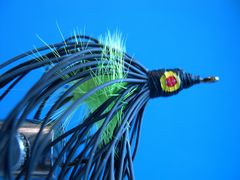 Step 15 After the yellow paint has dried I use the flattened end of a round toothpick to paint a red pupil. 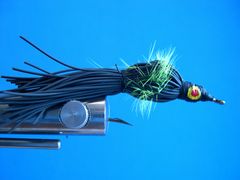 Step 16 I tie a piece of thread around the skirt, as shown in the photo, to keep the rubber strands out of the way when I'm applying epoxy to the head and later when I'm turning the fly on my epoxy drying device. 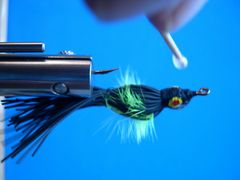 Step 17 Apply epoxy to the head with a round toothpick. The rotary vice is very useful in helping with this process as you apply epoxy to all parts of the head. 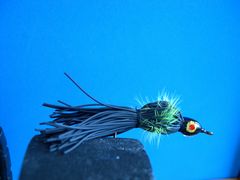 Step 18 Remove the Pig Boat from the vice and attach it to the drying wheel to finish the drying process. If you don't have a drying wheel but you do have a rotary vice, simply leave the fly in the vice and keep rotating the fly until the finish appears to be drying smoothly. Once you are satisfied that the epoxy won't run, leave the fly in the vice to cure. 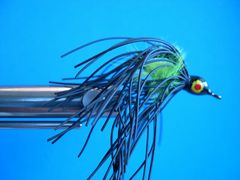 Step 19 Your Calcasieu Pig Boat is finished.
Warmwater Fly Tyer - by Ward Bean
© Copyright 2025 Ward Bean, Council Bluffs, IA, All rights reserved. © Copyright 2025 Ward Bean, Council Bluffs, IA, All rights reserved.
|